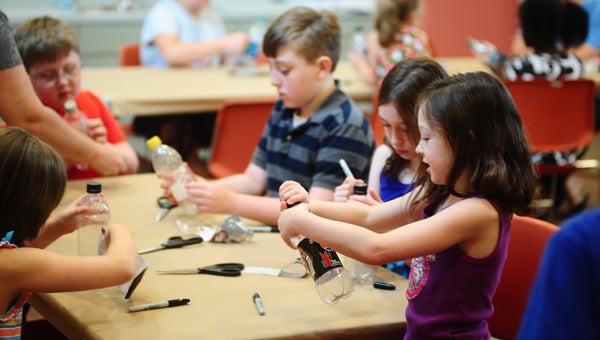Alabaster library kids’ club explores science
Published 4:39 pm Friday, July 11, 2014

The Albert L. Scott Public Library in Alabaster has hosted the children’s Glad Scientist Club, a combined reading and science club, from June 5 through July 10. (Reporter Photo / Jon Goering)
By CAROLINE CARMICHAEL/Staff Writer
ALABASTER—“Has anyone in your family ever invented anything?” asked Youth Services Librarian Frances Smith of the Albert L. Scott Public Library in Alabaster.
Three little hands shot into the air as 25 kids eagerly leaned forward in their seats.
These kids were members of the Glad Scientist Club held at the Albert L. Scott Public Library in Alabaster June 5 – July 10.
As part of the library’s science-themed Summer Challenge reading program, the Glad Scientist Club explored various aspects of science and scientific inventions with Alabaster children aged six and older.
The purpose of the club, said Smith, was “to combine reading books with learning science.”
Completed books could be recorded in the children’s reading logs to earn prizes.
About three books were visited each session.
The primary book, “What Color is My World?: The Lost History of African-American Inventors” by Kareem Abdul-Jabbar and Raymond Obstfeld, was read aloud by Smith each day, while “Fun Food Inventions” by Nadia Higgins, which provides a history of well known treats, was read aloud by young club members.
Smith completed each reading time with a biography, as well as a promotion of another biography in the library that the children might enjoy reading. These biographies combine fact with fiction, weaving an entertaining yet educational story for young readers.
“So that’s how trees got invented in the desert!” piped one little girl after Smith’s reading of “The Tree Lady: The True Story of How One Tree-Loving Woman Changed a City Forever” by H. Joseph Hopkins.
Kids discussed science and shared stories of their own scientific endeavors and modern technology experiences.
After reading time, the young club members participated in an activity based off of the session’s reading.
Such activities included electrical experiments and insect repellent-making instructions from Elinor and Winfield Burks, marshmallow robot constructions and birdfeeders and birdbaths crafting after a presentation from the Audobon Society.
“Everyone knows what a mad scientist is,” said Smith, “I just wanted this to make them ‘glad’ and maybe like science more than I do.”









